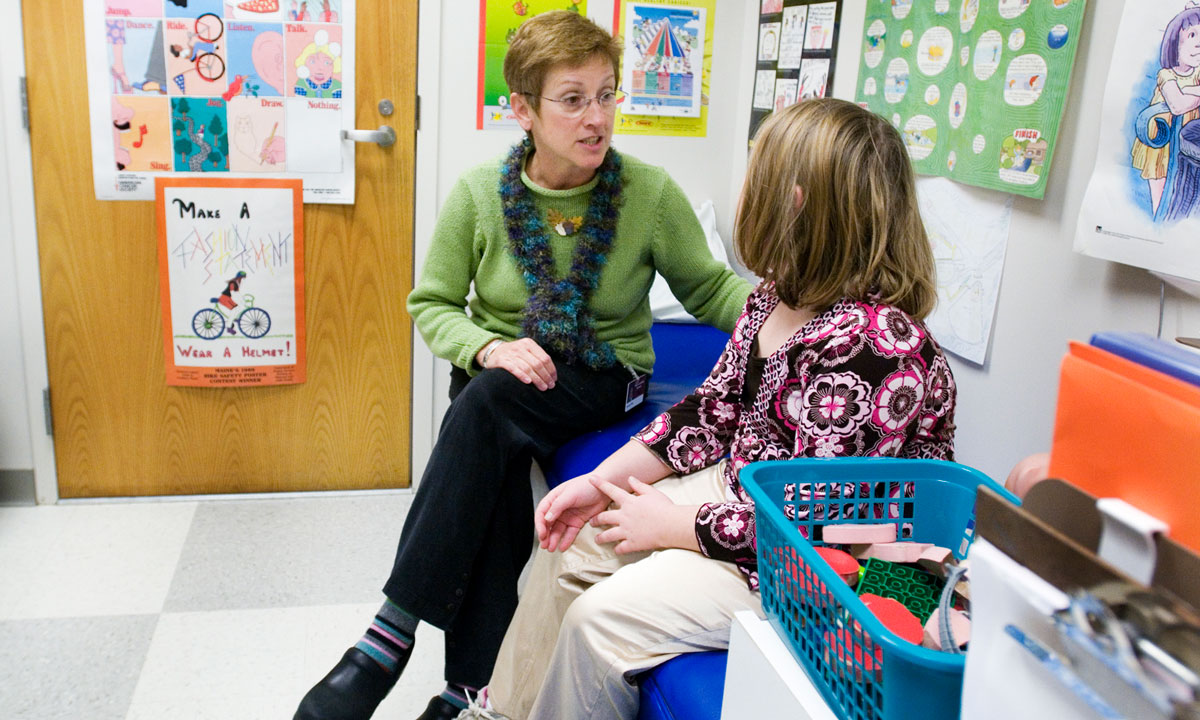New Study: School Nurses Are Untapped Resource to Combat Chronic Absenteeism
“Many people think our primary focus is to send children home, but actually our focus is to keep kids in school,” said school nurse Kate King.

Get stories like this delivered straight to your inbox. Sign up for The 74 Newsletter
Kate King has been a school nurse working with high-need students for 23 years. For as long as she’s worked in schools, she’s noticed a pattern: when students are struggling or don’t like a class, they’ll go to the nurse’s office to avoid it.
When confronted with this “age-old story,” as King calls it, she starts asking questions. Do you not like the class? Is something else going on? She checks their grades. And once she identifies the core issues, she provides the student with wraparound services, engaging school counselors, social workers, teachers and parents.

The main goal? To get students the support they need to return to class as quickly as possible. She calls school nurses “the sentinels,” arguing it’s their role to identify when there’s an issue and then pull together as many people as they can to support that child.
Her current school, World Language Middle School, a bilingual language immersion school in Columbus, Ohio, electronically tracks when students go to the nurse’s office so they can quickly identify these patterns.
“My primary focus — and a school nurse’s primary focus — is that children are in school,” she said. “Many people think our primary focus is to send children home, but actually our focus is to keep kids in school.”
King’s experiences mirror the results of a new study of 21 nurses out of the University of Missouri Sinclair School of Nursing. Researcher Knoo Lee, himself a registered nurse, found that students who have many partial-day absences often seek out school nurses as a source of comfort and support. This puts school nurses in a unique position to intervene before their absences become chronic.
“We discovered something that we haven’t seen before,” Lee told The 74, “where school nurses are actually in a position where they are able to identify students who are going through the early symptoms of partial-day absences.” Knowing that partial-day absences often lead to full-day absences, “we believe from these results that school nurses have the potential to play a key role in terms of really helping out with chronic absenteeism.”

Despite this, school nurses are often left out of policy-making decisions and conversations, Lee found. They also need access to greater support and resources to respond to the challenges students face that impact chronic absenteeism, including mental health concerns, homelessness, lack of transportation and food insecurity. And in order for school nurses to be effective, the report recommends that districts work to make sure schools are staffed with an adequate number who are trained and certified and that they have the needed supplies.
Especially post-pandemic, chronic absenteeism, when students miss 10% or more of school days a year, has proved to be an intractable problem. In the 2020-21 school year, at least 14.7 million students nationwide were chronically absent — more than double the number pre-COVID, according to Attendance Works, a nonprofit that aims to reduce chronic absenteeism. Children living in poverty are two to three times more likely to be chronically absent. Students from communities of color as well as those with disabilities are also disproportionately affected.
Historically, researchers looking at chronic absenteeism have largely ignored partial-day absences, according to Lee, even though they are more prevalent and can be a precursor to full-day absences. And both types impact academic outcomes. Lee’s study is the first to examine the effect school nurses can have on partial-day absenteeism, which is tracked differently from state-to-state and sometimes not at all.
The study is based on interviews with the nearly two dozen school nurses in six online focus groups between June and August 2020. Their years of experience varied and they worked in rural, urban and suburban schools across greater Minnesota. Nurses were also asked to complete a pre-interview survey. The study was conducted in collaboration with the Minnesota Youth Sex Trading Project, which is associated with the University of Minnesota School of Nursing and works to prevent the sexual exploitation of young people.
The research is the first to reveal that students who miss school partially are inclined to initiate their own visits to the school nurse’s office, according to Lee. These scenarios could involve a student trying to avoid a particular class; proactively stopping by the nurse’s office each morning to receive a meal they weren’t getting at home or needing to lie down after working late hours to help support their family. Once there, the nurses were able to intervene with these students and provide support. Since they didn’t have to seek out these “at-risk” students, identifying them was a relatively low lift with potentially big positive outcomes.
This demonstrates the importance of advocating for a more holistic understanding of the role of a school nurse, the study argues, particularly when it comes to offering mental and emotional support.
It becomes much more challenging for nurses to identify these absenteeism patterns if they’re not in the school building every day, according to King, who also serves as president of the more than 17,000-member National Association of School Nurses. On average, about two-thirds of public schools have access to a full-time school nurse, according to the association’s workforce study. In rural districts, this drops to 56% and in the West, it plummets to 16%. About 40% of school nurses rotate between at least two schools.
Parents — especially those whose kids have chronic illnesses — feel more comfortable sending their kids to school when there’s a nurse in the building every day, according to King. This is particularly true when students lack access to medical care outside of the school building. “We’ve seen so many times, the school nurse is the only health care provider that students see,” King said.
In addition to taking away that much-needed health care opportunity, when there is no school nurse for a student to see, they are more likely to be sent home: 18% of the time versus 5% of time, according to King.
While the number of schools that have full-time nurses has substantially increased since before the pandemic, King thinks that’s likely due to COVID relief funding. She worries a number of schools will once again lose access to a full-time nurse when that federal money runs out later this year.
Notably, the study took place during the first few months of the pandemic. Since then, chronic absenteeism has only gotten worse. While there have been lots of attempted interventions over the last few years, most school districts are still struggling to find the right mix, according to Lee, the researcher.
His study, he hopes, will highlight that “school nurses can really take a huge role in this.”
Get stories like these delivered straight to your inbox. Sign up for The 74 Newsletter

;)
